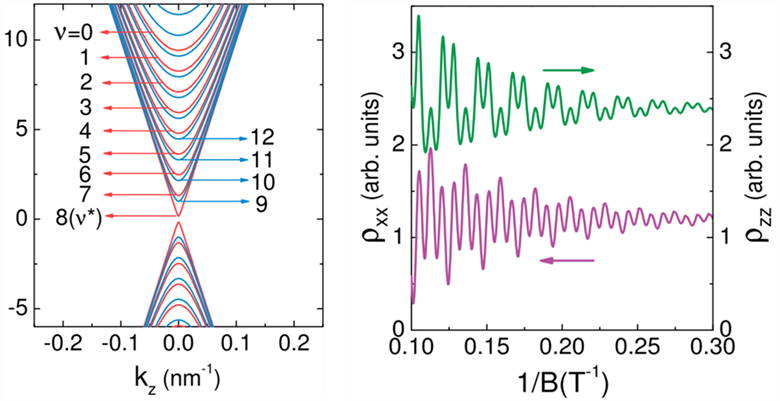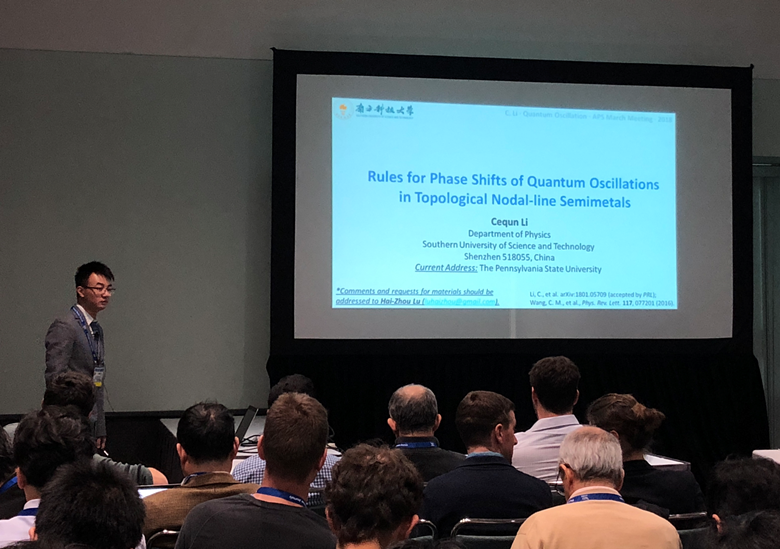Researchers make breakthrough in magnetic geometry-induced quantum geometry and nonlinear transport
2025-06-06SUSTech hosts IOP Forum with President of Institute of Physics Sir Keith Burnett
2025-03-26Researchers discover unusual thermal conductivity in high-symmetry single crystals
2025-03-26New efficient method detects quantum temporal correlations
2025-03-26Researchers explore unconventional magnons predicted by spin space groups
2025-03-25Recently, the prestigious physics journal “Physical Review Letters”, known as PRL, published a solid research entitled “Rules for Phase shifts of Quantum Oscillations in Topological Nodal-line Semimetals”, which is carried out 2017 graduate from Physics Department Cequn Li and Research Assistant Professor Chunming Wang. Associate Professor Hai-Zhou Lu is the corresponding author. SUSTech is the first author affiliation. This paper is coauthored by researchers from SUSTech, Nanjing University and Peking University.
Topological nodal-line semimetals are new family member of topological semimetals with nontrivial π Berry phase around the nodal line. The search for nodal-line semimetals and their topological properties are of fundamental interest, and how to distinguish between nodal-line semimetals, Weyl/Dirac semimetals and normal metals still remains a question to the science community. In experiment, by measuring oscillations of resistance or magnetism, and then fitting the phase shift, one can distinguish between Weyl/Dirac semimetals and normal metals: phase shifts for them are ±1/8 and ±5/8, respectively. Now the only missing piece of the puzzle is the phase shifts for nodal-line semimetals. To this end, for the first time Li et al. present theoretical studies on the phase shifts in nodal-line semimetals. In their work, Li et al. show that distinctly different from the case of Dirac/Wey semimetals, quantum oscillations in nodal-line semimetals shows clear anisotropy which arises from the torus topology of the Fermi surface. They propose that by fitting phase shifts in both perpendicular and parallel magnetic field, one is able to probe the nodal line and its nontrivial Berry phase. Furthermore, they extract general rules for phase shifts of quantum oscillations which can be generalized to other topological phases. In this way, Berry phase and the topology of the Fermi surface can be fully resolved by quantum oscillation experiments. Their results not only clarify confusions and controversies in this field, but also provide important insight in exploring transport signatures of topological nodal-line semimetals. Referees thought highly of the work by Li et al. and pointed out in the review report: “The article of Li et. al., comes very timely and addresses a very important issue of observed shifts in magnetic oscillations seen in nodal line semimetals, that so far is mostly ignored in the theoretical communities”, and “current work is timely to clarify confusions and controversies in this field. This manuscript is well organized. Discussions and conclusions are crystal clear for both general principles and specific materials.”
Cequn Li was an undergraduate from the Department of Physics class of 2013 to 2017, and now a PhD candidate at Pennsylvania State University, University Park. He started this research since his third year and finished most of the theoretical calculations during his fourth year. It is worth noting that this is his third paper published in international academic journals during his undergraduate research. Before that, his research on improving activity of metal oxide surfaces was published in the Journal of Chemical Physics, and another paper entitled “CO adsorption on graphite-like ZnO bilayers supported on Cu(111), Ag(111), and Au(111) surfaces” was published in the Journal of Physical Chemistry C, research of which was done during his visit at University of Milano-Bicocca, Italy. In March this year, he went to APS March Meeting held in Los Angeles, and gave a conference talk on quantum oscillations in topological nodal-line semimetals.
This work was supported by National Basic Research Program of China, the National Key R & D Program, the National Natural Science Foundation of China, and the Science, Technology and Innovation Commission of Shenzhen Municipality.

Fig 1. Fermi surface in topological nodal-line semimetals

Fig 2. Landau levels (left) and quantum oscillations of resistance (right) in strong magnetic field

Fig 3. Cequn Li’s talk in APS March Meeting 2018 in Los Angeles